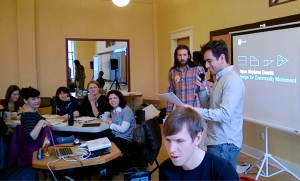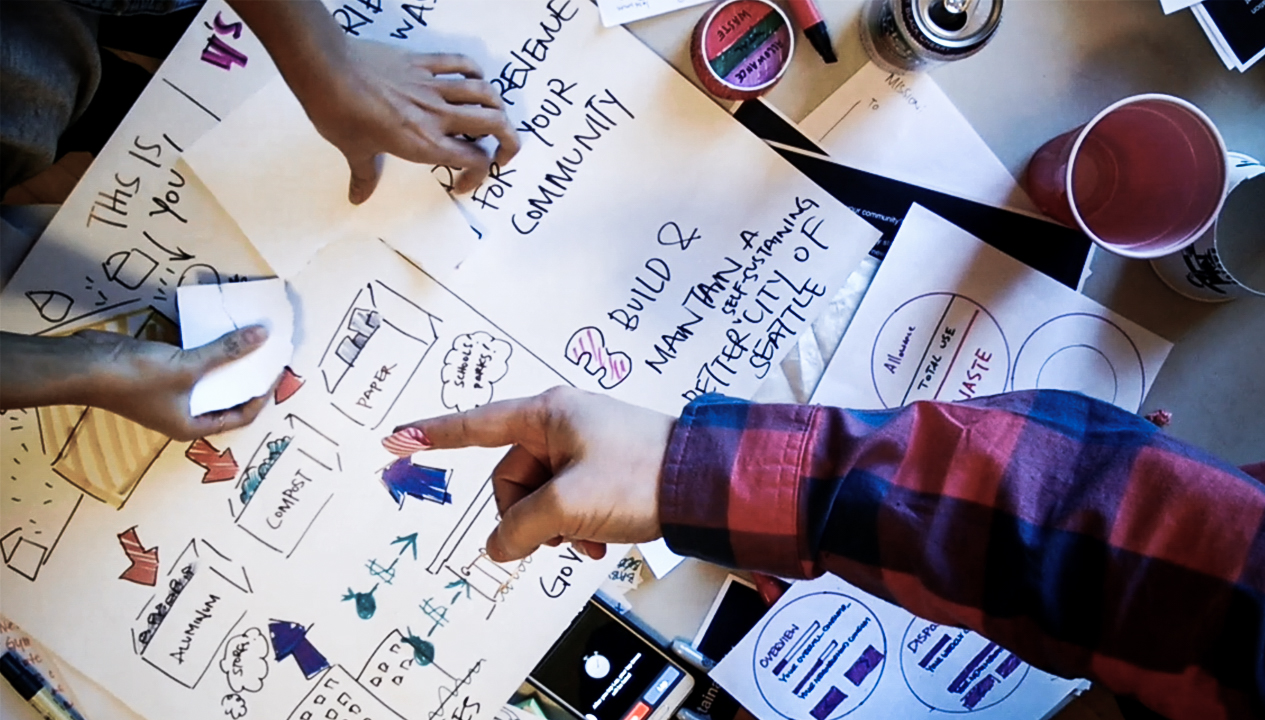Erik Molano (Graphic Design ’12) enjoys working closely with individuals and organizations to produce identity systems and experiences across print, screen, and spatial media. He utilizes the power of branding, typography, and art direction to communicate messages that matter. Currently, he is a designer at Microsoft and has worked with the Los Angeles Unified School District, Southern California Public Radio, Warp Records, The Good Samaritan Society, the Los Angeles County Arboretum, and The California Institute of Technology. He is also a TEDx conference organizer, and serves on the AIGA Seattle sustainability committee. Erik received his BFA in graphic design from Art Center College of Design in 2012, and graduated with the Designmatters Concentration in Art and Design for Social Impact.
Creating Community Movement Through Design
Throughout my education, I had always been fascinated by the power of graphic design. It’s everywhere. In books, freeway signs, software applications, automobile dashboards, cereal box packaging, architectural wayfinding, maps, and so much more. The thoughtfulness and intention that goes into the communication we consume daily is so ubiquitous we sometimes forget that it’s carefully crafted by a worldwide community of graphic designers. Since I had become a part of this community, I challenged myself to find a place within it; to discover my full potential.
I began to ask myself, ‘What’s the most impact I can have as a designer? Is there more to design than just laying out images and text in a beautiful way? How does our work impact culture?’ After a few years of soul-searching, I found my answer lying within the world of social innovation, with many thanks to the following three catalysts.

(left) David Butler, (middle) First Things First Manifesto, (right) Jessica Helfand and William Drenttel
The first major epiphany came from David Butler, who at the time was the vice president of global design at Coca-Cola. In a talk titled “Redesigning Design” at the 2009 AIGA Make/Think conference, he discussed the ways designers can begin to solve problems holistically. His talk introduced me to the concept of wicked problems: major problems that affect the lives of people that have never been solved before (i.e. providing access to clean water for every person on the planet). You can view his talk here.
I later discovered The First Things First manifesto by Ken Garland, which was signed by 22 designers in 1964, then edited and revived in 2000. The manifesto aimed to shift the industries of advertising and design from a consumerist focus to a more humanistic approach. More facts about it here.
Lastly, the talk by Jessica Helfand and Bill Drenttel that launched the renowned blog Design Observer, titled “Culture is Not Always Popular.” This incredibly powerful talk (presented way back in 2003) challenged designers to tackle issues and projects that exist outside of our mainstream consumer culture. It’s beautifully written and harshly critical on our culture of design. You can read it here.
 Since graduating from Art Center and moving to the Pacific Northwest, I’ve joined the AIGA Seattle sustainability committee, and I’m proud to say that we completed our first design workshop called Paper Airplane. The name was inspired by the notion that a single sheet of paper, with enough ingenuity and deft folding, can be flown around a classroom like a kite on a windy day. That same creativity, when focused on a community, can bring about solutions that light a fire under its residents and inspire them to change the world, starting with their very own block.
Since graduating from Art Center and moving to the Pacific Northwest, I’ve joined the AIGA Seattle sustainability committee, and I’m proud to say that we completed our first design workshop called Paper Airplane. The name was inspired by the notion that a single sheet of paper, with enough ingenuity and deft folding, can be flown around a classroom like a kite on a windy day. That same creativity, when focused on a community, can bring about solutions that light a fire under its residents and inspire them to change the world, starting with their very own block.
We gathered 30 creative thinkers (designers and non-designers, alike) under the same roof to solve a community problem through sustainable design thinking. Our theme focused around reversing our throw-away culture.
There was a time when people drank coffee out of real ceramic mugs, bought produce that wasn’t packaged in cardboard and plastic, and avoided buying products that would become obsolete in six months. At some point we shifted. Shifted toward throw-away paper cups that can’t be recycled. Shifted toward shrink-wrapping multi-packs of bell peppers. Shifted toward buying into the latest trend instead of quality products that would last a decade or more. Design thinking has the power to tackle big problems, so we decided to challenge the Seattle creative community to put their minds together with the goal of reversing this trend. The solution is entirely up to them, and we had just three criteria:
1. It must be actionable: realistic and able to happen tomorrow.
2. It must be sustainable: you must consider the economy, environment, people and culture.
3. It must be for the community: we’re designing for people, not ourselves.

(left) Teams present their project ideas to each other, (right) Sketches that analyze a waste stream from home to city
To kick start the workshop, we shared some case studies such that showed a conscious effort to reduce waste in their business and in manufacturing. We then broke up the attendees into 6 teams of 5 people, and then unleashed the creatives to use sustainable design thinking to solve real world problems. Each team came back with a 10 minute pitch, explaining their idea, the market, the audience, how it would work, and how much it would cost.
Some of the ideas that arose were smart home meters that showed energy consumption and waste disposal patterns, stores that sell ideas rather than products, modular food systems within a grocery store to reduce packaging and simplify cooking, and a point-and-reward system for commuters who traveled responsibly.
As part of the workshop planning team, we wanted the event itself to embody the values we were advocating. We minimized paper printing by making workshop packets per team rather than per person, created a democratic voting system using recycled bottlecaps and voting glasses, provided used paper and writing supplies for the sketching activities, and for the best overall project, created awards that were custom-built by our team, using parts from a secondhand hardware store.
The workshop was considered a success, and with the feedback we received, we hope to implement our Paper Airplane event format at every AIGA chapter across the nation. Throughout this process, I learned that change can be made in small ways. With the help of a little persistence and local outreach, the thrill of transforming a community can spread like wildfire throughout the hearts and minds of its inhabitants. I strongly believe that collectively, we can shape the world (and have some fun doing it, too).
This section is dedicated to featuring the current work of Art Center alumni who are making promising contributions in social impact design. If you want to nominate an alumni story or project to be featured in this space, contact elisa.ruffino@artcenter.edu

